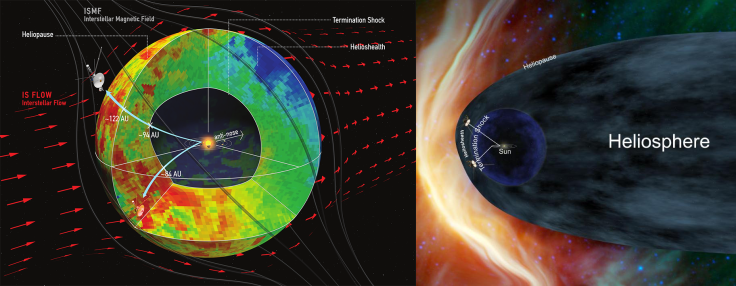Heliosphere, Our Sun's Sphere Of Influence, Is Not Shaped Like A Comet

The heliosphere, despite the “sphere” in its name, has long been picturized with a comet-like tail trailing behind the sun. Analysis of new observations by NASA’s Cassini and the two Voyager spacecraft and the Interstellar Boundary Explorer (IBEX) satellite, however, has revealed that this gigantic bubble of charged particles powered by solar winds may be more spherical than previously thought.
The observations, detailed in a study published Monday in the journal Nature Astronomy, suggest that the heliosphere may be rounded on both ends — a shape very different from the wind sock-like like structure it was, until now, believed to have.
Read: NASA Captures Corona’s Transition Into Solar Wind
“Instead of a prolonged, comet-like tail, this rough bubble-shape of the heliosphere is due to the strong interstellar magnetic field — much stronger than what was anticipated in the past — combined with the fact that the ratio between particle pressure and magnetic pressure inside the heliosheath is high,” study lead author Kostas Dialynas, a space scientist at the Academy of Athens, said in a statement.
The heliosheath is the outer region of the heliosphere, which lies just beyond what’s called the “termination shock” — a point where the speed of solar wind drops abruptly, and the effects of interstellar wind become discernable.
The heliosphere, which extends far beyond the orbit of Neptune, is roughly 23 billion miles across. As the sun moves through interstellar space, so does the heliosphere. This is what led scientists to believe that the heliosphere was comet-shaped, with a rounded head and an extended tail.
Scientists used an instrument on-board Cassini, which has been exploring the Saturn system since 2004, to study an entire 11-year solar activity cycle. The instrument measured the neutral atoms pinged back from the interstellar medium toward the inner solar system — a phenomenon that occurs when charged particles from inner solar system reach the boundary of the heliosphere.
If the heliosphere’s tail is stretched out like a comet, the particles coming from the tail of the heliosphere would reflect changes in the number of particles coming from the sun much later than those coming from the “nose” of the heliosphere.
This is not what scientists observed. They found that patterns from solar activity show just as quickly in tail particles as those from the nose, indicating that the tail is roughly the same distance from us as the nose.
“A rounded heliosphere could come from a combination of factors,” NASA said in the statement. “Data from Voyager 1 show that the interstellar magnetic field beyond the heliosphere is stronger than scientists previously thought, meaning it could interact with the solar wind at the edges of the heliosphere and compact the heliosphere’s tail.”
© Copyright IBTimes 2025. All rights reserved.






















